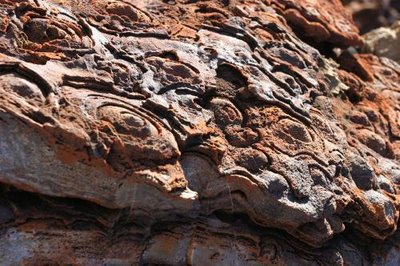Some of the earliest fossils in the world come from around Australia (Pilbara Supergroup) and South Africa (Onverwacht and Nondweni groups) (1) and date to around 3.4 billion years old. These fossils consist of stromatolites, structures formed by bactera interacting with sediment. This is at least what people assumed until some researchers suggested the structures were in fact of abiotic origin. New research on the Strelley Pool Chert recently published in Nature attempts to demonstrate the biological origin of these structures (2).
The research team has a Pilbara wiki and they have a good info so i will just quote from them:
"The ancient reef is cut off one end by a fault, and at the other as it disappears into what would have been deep water, not liked by the microbial communities that created the stromatolite structures, just like modern ones.
“If you start at the deep water end and trace it along the reef system, the numbers of stromatolite shapes increase and become more complex and varied, just as occurs in biological reef systems throughout the geologic record,” she says. “It is a classical biological response to the environment.”
Her other lines of evidence include the individual structures and the association of morphologies (shapes), the spatial distributions, and the way those relate to the palaeo-environment. Analysis of the rare earth element chemistry (with Balz Kamber, Laurentian University) confirms the deposition of the fine-grained sedimentary rocks known as chert and carbonate that make up the stromatolites happened in a marine environment.
“If you take a vertical section through time there is a brief change from the high temperature hydrothermal and volcanic deposition that dominated the Pilbara at the time to a shallow marine environmentt in which life flourishes virtually immediately, “ she remarks. “And then back again to another volcanic and hydrothermal episode, when the stromatolites disappear. This speaks volumes about the conditions that may have nurtured early life” From Here
Another paper recently described structures called 'endolithic microtubes' in the Strelley Pool chert (3) that they interpreted as being of microbial origin providing futher independant evidence of the biological origin of these fossils. So overall i think the case biological origin for these structures is fairly solid.
There are microfossils from the area discovered by Schopf but these are more dubious.
There are older fossils dating to nearly 3.5 billion years ago in the Pilbara Supergroup belonging to the Dresser Fromation. In the light of this research these can also probably be more confidently called biological in origin. If this is the case I think these are the oldest currently known visible traces of life on earth.
Refs:
1) Fossil evidence of Archaean life
J. William Schopf
Phil. Trans. B. Volume 361, Number 1470 / June 29, 2006
Link
2) Stromatolite reef from the Early Archaean era of Australia
Abigail C. Allwood, Malcolm R. Walter, Balz S. Kamber, Craig P. Marshall and Ian W. Burch
Nature 441, 714-718 (8 June 2006)
Link
3) A fresh look at the fossil evidence for early Archaean cellular life
Martin Brasier, Nicola McLoughlin, Owen Green, David Wacey.
Phil. Trans. R. Soc. B. Volume 361, Number 1470 / June 29, 2006
Link
Pilbara Wiki - excellent resource with things like images, and maps and a reef FAQ.


No comments:
Post a Comment